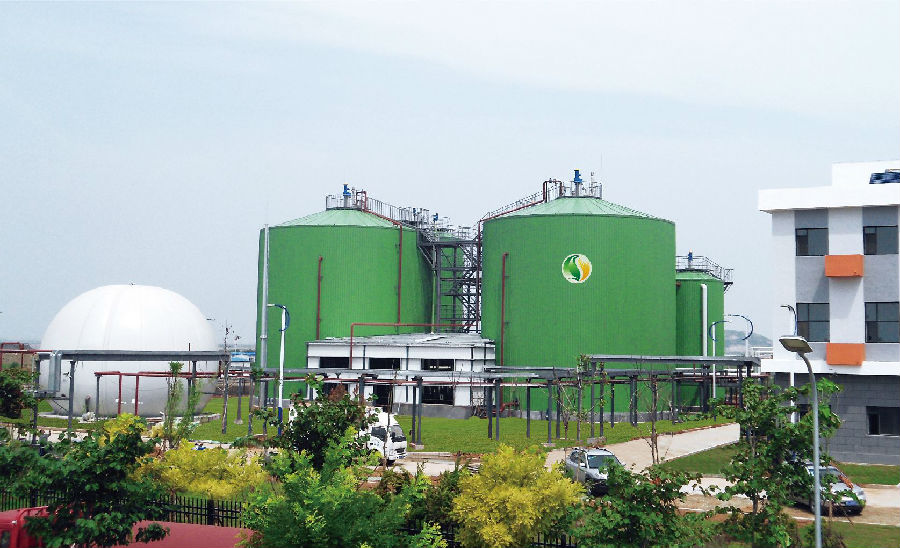The new technology processes organic waste in two phases.
這項新技術處理有機廢物需要兩個階段。
Remember, APS stands for Anaerobic Phased Solids digestion.
記住,APS代表厭氧分步分解固體法。
First, the waste material is loaded into a large, closed container, along with different types of anaerobic bacteria.
首先,把廢物材料和多種不同的厭氧細菌一起裝入一個大的閉合容器中。
The bacteria break the solids down into acids and hydrogen gas.
細菌會把固體分解成酸和氫氣。
The hydrogen is extracted and the remaining acids are transferred into a different container for the second phase of the process.
將氫氣抽出,剩下的酸運輸到另一個容器里,準備進行第二階段。

There another type of bacteria converts the acids into methane gas.
在這個階段,另一種細菌會將酸轉化成甲烷。
Student: Aren't hydrogen and methane gas bad for the environment though?
學生:但氫氣和甲烷不是對環境有害嗎?
Professor: The answer in this case is no, because they don't escape into the atmosphere.
教授:這種情況下并非如此,因為氣體不會泄露到大氣中。
The gases are captured and can be burned to produce electricity, which saves a lot of money and ultimately decreases our need for fuels like petroleum and coal, which are not only expensive but are also polluting.
這些氣體會被收集起來,燃燒掉以發電,就能省下一大筆錢,還能從根本上降低人們對像汽油和煤炭這種燃料的需求,這些燃料不僅很昂貴,還會污染環境。
Student: So organic waste from landfills could be processed this way?
學生:那垃圾填埋區里的有機廢物也能用這種方法處理?
Professor: It is certainly one possibility.
教授:這很有可能。
And APS digestion systems are very versatile.
而且APS分解系統非常多用。
They can be installed just about anywhere.
任何地方都能安裝。
See, anaerobic digestion systems used at waste water treatment plants are huge tanks that hold thousands of gallons of waste water.
污水處理廠里的厭氧分解系統是(用到)巨大的貯水池,里面有幾千加侖的廢水。
But the APS containers are small enough to be set up on site, where the waste is generated, like at food processing plants or on farms.
但APS容器足夠小,能在現場安裝,即產生廢物的地方,像是食品加工廠或農場。
So garbage doesn't have to be transported long distances.
人們就不用長途運輸垃圾了。
As a matter of fact, a couple of universities successfully set up demonstration projects.
實際上,已經有好幾個大學成功設立了示范項目。
They collected food scraps from dining halls and local restaurants and process them in APS facilities.
它們收集來自食堂和當地餐廳的食物殘渣,用APS設備進行處理。
Not only did the university save money, we are also learning even more about the APS process.
學校不僅節省了金錢,我們還能了解到更多關于APS進程的知識。
What is the next step forward?
下一步是什么呢?
Well, APS digestion uses several different types of anaerobic bacteria, right?
APS分解法會用到好幾種不同的厭氧細菌,對吧?
So what are the most efficient bacteria in the process?
那整個過程中,最高效的細菌是哪種呢?
If researchers can figure that out, the highest performing bacteria mix for a system could be determined.
如果研究人員能把這個問題弄清楚,就能確定出一種對某系統而言具有最高效率的細菌混合物了。
Ultimately the goal would be to grow enough of these particular bacteria to support large-scale commercial APS systems.
最終的目的是培育出足夠多的細菌來供大規模的商業化APS系統使用。
What is the lecture mainly about?
這節課主要講了什么?
What is the professor's opinion about the use of landfills to manage solid organic waste?
對于通過垃圾填埋來處理有機固體廢物,教授持什么觀點?
What does the professor imply about processing solid organic waste in equipment designed for processing wastewater?
對于用處理廢水的設備里處理有機固體廢物,教授暗示了什么?
What does the professor suggest about methane and hydrogen gas?
對于甲烷和氫氣,教授的話說明了什么?
According to the professor, what are two advantages of APS digestion systems?
根據教授所言,APS分解系統的兩大優勢是什么?
What does the professor say is a promising focus for future research into APS digestion systems?
教授說的在對APS分解系統未來的研究中,一個很有希望的關鍵點是什么?










